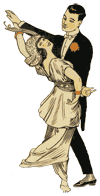 |
ROUND DANCING — CHOREOGRAPHED BALLROOMEDUCATIONAL ARTICLESMAJOR SECTIONS: Figures | Articles | Links | Alph. Index | Search | Home |
|
|
Round Dance Tips by Tim Eum—ActionsWhen Roundalab defines something, it is not always a figure. A figure is a series of steps usually taking one, two, or four measures of music to do. There are some figures that take only two beats (i.e. half a measure) to do. If something takes only one beat of music while taking a step (i.e. changing weight to the other foot) then it is defined as a “movement,” not a figure. If something takes only one beat of music and you don’t take a step then it is defined as an “action.” SWIVEL — Turn on the ball of your foot and securely steady your body over that foot by relaxing the knee and lowering into the leg.Roundalab defines the Swivel as “a turning of the body causing the foot or feet to rotate while maintaining contact with the floor.” A swivel can turn as little as 1/8 or as much as a half. The secret to swivelling smoothly is to get up onto the ball of the foot. You cannot turn if you are flat footed. To keep your balance as you swivel, you must get all your weight over the supporting foot and it helps to bend the knee a little. FAN — Keep the fanning leg straight and low enough that the toe “grazes” the floor. Roundalab's definition for the Fan is “The free foot with the toe in contact with the floor moves either forward or backward in an arc similar to the opening or closing of a hand fan. The knee of the supporting leg is relaxed throughout the action.” Note that as defined there is no swiveling action on a fan. However, you still relax the knee of the supporting leg to help you balance more firmly as you fan the free leg. Make sure to keep the fanning leg straight and point the toe. Although the definition says to keep to fanning foot in contact with the floor, you do not “drag” it on the floor; in fact you should have it just above the floor and move it with a light “grazing” action. FLARE — Just like a Fan but with the fanning leg higher off the floor. The Flare is defined as “The free foot moves either forward or backward and out to the side (similar to the Fan) but with the foot slightly off the floor.” Everything said about the Fan applies to the Flare. Soften the knee of the supporting leg so as to keep balance better. Use very little or no swivel action. Keep the flaring leg straight and toe pointed out. The one difference is the height of the flaring leg. It could be knee high or higher, but most round dancers flare the leg about a foot off the ground. Note that fans and flares can go either direction (in or out) with whichever foot is free. RONDE — This is a Fan or Flare but with perhaps a bit more speed, larger arc, or in combination with a spin, pivot, swivel, or other turning movement. The Ronde is defined as “An action in which the free foot moves either forward or backward in an arc. The knee of the supporting leg is relaxed throughout the action. The ronde action may be in the air (Aerial Ronde) or on the floor (Floor Ronde). When you really look at it, the Ronde is simply a Fan or a Flare. But when combined with things you do in advanced round dancing, it looks fancier and perhaps deserves the fancier name. When combined with a slipping movement you get the phase-six figure “Ronde and Slip.” When combined with a right lunge movement and hip rotation, you get the phase-six figure “Rudolph Ronde,” which often comes at the end of a pivot series.
Tim Eum originally prepared these Tips for
|
 |
|
|
Page last revised